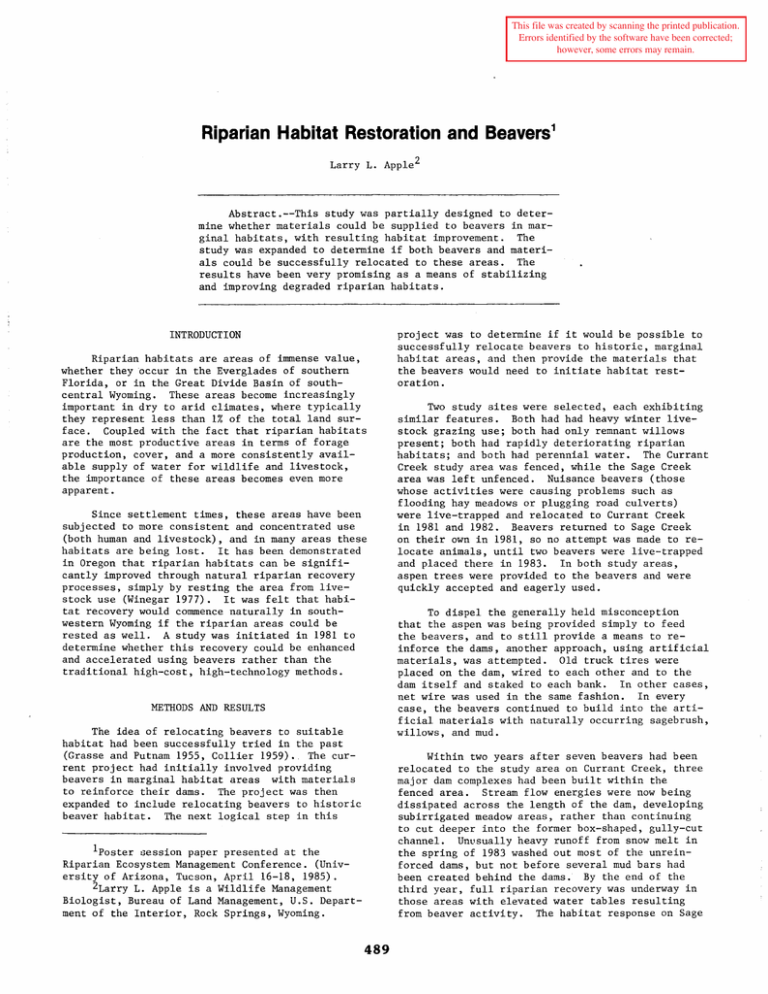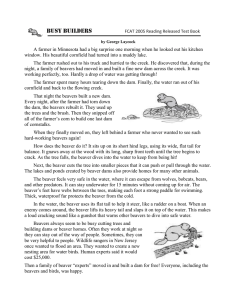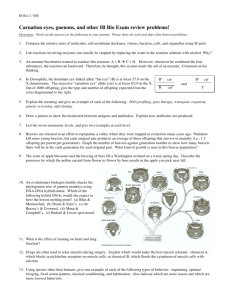Riparian Habitat Restoration and Beavers
advertisement

This file was created by scanning the printed publication. Errors identified by the software have been corrected; however, some errors may remain. Riparian Habitat Restoration and Beavers1 Larry L. Apple 2 Abstract.--This study was partially designed to determine whether materials could be supplied to beavers in marginal habitats, with resulting habitat improvement. The study was expanded to determine if both beavers and materials could be successfully relocated to these areas. The results have been very promising as a means of stabilizing and improving degraded riparian habitats. INTRODUCTION Riparian habitats are areas of immense value, whether they occur in the Everglades of southern Florida, or in the Great Divide Basin of southcentral Wyoming. These areas become increasingly important in dry to arid climates, where typically they represent less than 1% of the total land surface. Coupled with the fact that riparian habitats are the most productive areas in terms of forage production, cover, and a more consistently available supply of water for wildlife and livestock, the importance of these areas becomes even more apparent. Since settlement times, these areas have been subjected to more consistent and concentrated use (both human and livestock), and in many areas these habitats are being lost. It has been demonstrated in Oregon that riparian habitats can be significantly improved through natural riparian recovery processes, simply by resting the area from livestock use (Winegar 1977). It was felt that habitat recovery would commence naturally in southwestern Wyoming if the riparian areas could be rested as well. A study was initiated in 1981 to determine whether this recovery could be enhanced and accelerated using beavers rather than the traditional high-cost, high-technology methods. METHODS AND RESULTS The idea of relocating beavers to suitable habitat had been successfully tried in the past (Grasse and Putnam 1955, Collier 1959). The current project had initially involved providing beavers in marginal habitat areas with materials to reinforce their dams. The project was then expanded to include relocating beavers to historic beaver habitat. The next logical step in this project was to determine if it would be possible to successfully relocate beavers to historic, marginal habitat areas, and then provide the materials that the beavers would need to initiate habitat restoration. Two study sites were selected, each exhibiting similar features. Both had had heavy winter livestock grazing use; both had only remnant willows present; both had rapidly deteriorating riparian habitats; and both had perennial water. The Currant Creek study ar.ea was fenced, while the Sage Creek area was left unfenced. Nuisance beavers (those whose activities were causing problems such as flooding hay meadows or plugging road culverts) were live-trapped and relocated to Currant Creek in 1981 and 1982. Beavers returned to Sage Creek on their own in 1981, so no attempt was made to relocate animals, until two beavers were live-trapped and placed there in 1983. In both study areas, aspen trees were provided to the beavers and were quickly accepted and eagerly used. To dispel the generally held misconception that the aspen was being provided simply to feed the beavers, and to still provide a means to reinforce the dams, another approach, using artificial materials, was attempted. Old truck tires were placed on the dam, wired to each other and to the dam itself and staked to each bank. In other cases, net wire was used in the same fashion. In every case, the beavers continued to build into the artificial materials with naturally occurring sagebrush, willows, and mud. Within two years after seven beavers had been relocated to the study area on Currant Creek, three major dam complexes had been built within the fenced area. Stream flow energies were now being dissipated across the length of the dam, developing subirrigated meadow areas, rather than continuing to cut deeper into the former box-shaped, gully-cut channel. Unusually heavy runoff from snow melt in the spring of 1983 washed out most of the unreinforced dams, but not before several mud bars had been created behind the dams. By the end of the third year, full riparian recovery was underway in those areas with elevated water tables resulting from beaver activity. The habitat response on Sage 1Poster session paper presented at the Riparian Ecosystem Management Conference. (University of Arizona, Tucson, April 16-18, 1985). 2Larry L. Apple is a Wildlife Management Biologist, Bureau of Land Management, U.S. Department of the Interior, Rock Springs, Wyoming. 489 Creek was similar, but because the stream profile here was more radically u~shaped, recovery was somewhat slower. After the ponds behind the dams silted in, the beavers shifted their activities upstream and built new dams. DISCUSSION AND RECOMMENDATIONS The intent of the study is not to create habitat for the beaver. The intent has been, and continues to be to improve riparian and aquatic wildlife habitats, using the beaver as a management tool. Although this technique is not a cure-all, it does appear to be a promising method, applicable in many dry, cool-desert situations. The riparian habitats on the study portions of Currant Creek and Sage Creek have improved significantly due to beaver activity. Coupled with rest from livestock grazing, which provided for accelerated willow regrowth, the system has become self-supporting in only three years. The process, stated simply and briefly, is this: beaver activity typically reduces the ability of the stream to transport sediment by reducing the effective slope of the stream channel. A series of beaver complexes reduces the stream flow velocities, thereby reducing the erosion potential of the moving water. The carrying power of the water is reduced, leading to accelerated deposition rather than erosion. The elevated water table that results locally from the activity of the beaver, leads to an extended period of time into the growing season, when subsurface water is in storage along the banks of the stream, and available for vegetative development. The ultimate objective is to vegetatively stabilize the beaver dam and the soil that is deposited behind the dam, thereby reestablishing the riparian vegetative community. If relocating beavers is anticipated, then a number of techniques might be worth considering. For best results, rest from grazing, to help achieve a more rapid vegetative recovery, is necessary, either with fencing or through a grazing management system. Because most dam-building activity do~s not begin until late summer or early fall, livetrapping and relocating of beavers, or providing aspen or other reinforcing materials should be done at this time. Providing aspen or other means of reinforcing beaver dams is also most effective when done at an already active beaver dam site. 490 When using aspen, place the trees on the bank near the active beaver dam, rather than in the water. Experience with beavers at these study sites indicates that they more readily accept and use aspen when it is placed on dry land. They also seem to accept artificial reinforcment,.such as net wire or a layer of tires, and will continue to build naturally occurring materials into the structure of the dam. Fortunately, beavers are very adaptable animals. An important feature of the study has been to determine the response of wildlife to the improved habitat conditions at the study locations. The bulk of the monitoring to date has been done at the Currant Creek area. Bird transects, fish surveys, and wildlife observations indicate that the overall response to the improved habitat conditions resulting from beaver activity and rest from livestock grazing has been quite good. Avian species richness has increased by approximately 20%, marsh hawks and mallards are now nesting within the study area, deer are fawning and rearing young in the heavy riparian vegetation, and brown and rainbow trout have moved into the study area from Flaming Gorge Reservoir. Probably the most serious threat to any wildlife population is the loss of its habitat. Healthy riparian and wetland habitats are crucial to the life cycles of a great diversity of wildlife and plant species. This is especially true in the arid western United States, where water is a very precious commodity. Improving or restoring riparian habitats is not an easy task. The use of beavers to help accomplish this end is not a panacea, and may not be applicable in all situations. However, a beaver management program designed to solve a specific habitat problem should be considered in any riparian habitat management strategy. LITERATURE CITED Collier, E. 1959. Three against the wilderness. 349 p. E.P. Dutton, Inc., New York, N.Y. Grasse, J.E., and E.F. Putnam. 1950. Beaver management and ecology in Wyoming. 75 p. Bulletin No. 6, Wyoming Game and Fish Department, Cheyenne, Wyoming. Revised 1955. Winegar, H.H. 1977. Camp Creek channel fencingplant, wildlife, soil, and water response. Rangeman's Journal 4(1):10-12.





